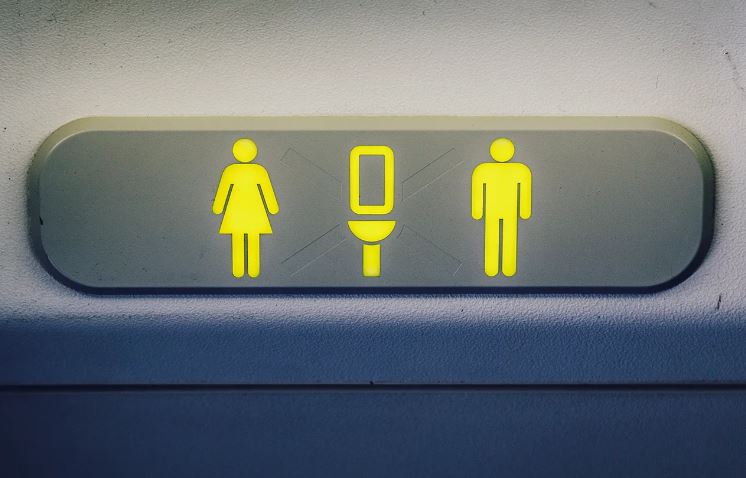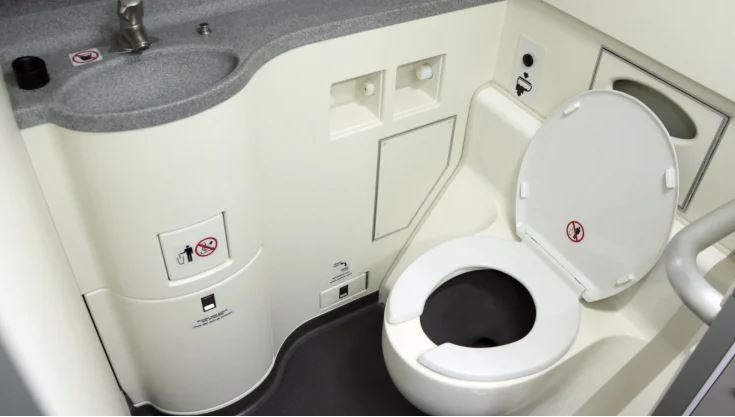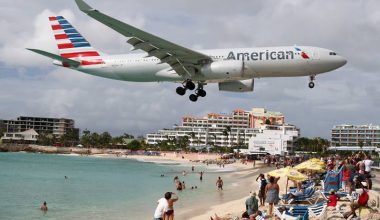Let’s face it- airplane toilet isn’t the most pleasant subject of discussion, but it is a must-have facility on passenger flights. Many passengers avoid using the lavatory on a flight and try holding it until arrival. But some bathroom breaks are inevitable, and sometimes one can’t hold it any longer. The airplane toilet is an important part of the cabin interior designed for passengers to relieve themselves during the flight

The toilet is an essential place to visit whenever nature calls, whether at home or on an outside trip. As much as we hesitate to talk about it, we can’t ignore the need for proper lavatories while traveling. Recognizing this need, airplane manufacturers have fitted aircraft with a bathroom or lavatory to provide sanitary facilities for passengers and crew alike.
Development of airplane toilets
In the early days of commercial aviation, airplanes had no dedicated lavatories. As time progressed, airlines started fitting planes with a toilet to ensure the well-being of passengers. With advancements in air travel, aircraft toilet designs have undergone radical transformations to maximize the hygienic and comfortable experiences for flyers.

Modern-day lavatories are more than just functional spaces and are integral to customers’ overall flight experience. The condition of toilets can directly affect the customer’s hygiene and satisfaction. Airplane toilets can make or break passengers’ flight trips and change their perception of the airline.
Size of an airplane toilet
A newbie flyer may be shocked at how small airplane toilets are. Given the need to boost aircraft seating capacity, airlines have reduced the lavatory space to squeeze more passengers onto planes. The financial fortune of any carrier rests on its ability to utilize every inch of aircraft-the most valuable asset. So there’s a unique challenge for airlines to maximize the functionality of lavatories while maintaining adequate levels of hygiene and comfort in a minimal space. Installing a slimline facility won’t be much of an issue if the aircraft is bathroom-friendly.
The size of airplane toilet and the ratio of lavatories to passengers differ according to airline and class of service. Some top-notch carriers offer spacious, thoughtfully designed, stylish, and well-maintained bathrooms for high-paying customers.
How does an airplane toilet work?
Before understanding how airplane toilet works, let’s build ground on the working mechanism of household/regular toilets. Regular toilets use siphons to flush and rely on standard gravity drainage for sewage collection. The water siphons the stuff we flush down the toilet and drains via gravity to a sewage system or septic tank.
In contrast to standard toilets, aircraft lavatories can’t be built using a gravity sewer system due to the lack of a septic system to collect the waste. The Siphon toilet system won’t suit modern aviation needs and is impractical since it can’t handle spillage. Then, how does an airplane toilet work?
Commercial airplane toilets use a vacuum-based flushing mechanism that essentially sucks the waste out of the toilet bowl. When you flush the toilet or press the flush button, a valve in the sewer line opens, releasing vacuum energy stored in the system, the vacuum in the line will gulp the waste contents out of the toilet and push it to the holding tank.

Based on differential air pressure, the VacuFlush system maintains a vacuum between flushes. As the vacuum provides energy, no electricity is needed to open and reseal the valves. The sewage accumulated in the vacuum collection tank at the vacuum station is pumped directly into a waste storage tank. The waste is moved through a network of pipes and trapped within a closed waste tank system, often located in the rear end of the aircraft.
Once the plane is safely on the ground, specialized tankers will use hoses to suck the waste to their holding tanks. The plane’s tank is emptied, and the collected waste is released into the purpose-built drainage system.
Vacuum sewer systems require less water for flushing and minimize weight on aircraft. It has minimal water use and no sedimentation due to self-cleansing high velocities. With reduced energy costs and operational expenses, the vacuum system efficiently discharges waste lines. Some of the advantages of this system include:
- Minimal use of a pint of water per flush
- Easy to install and cheap to maintain in the long term
- Elimination of mal odors along the closed vacuum sewers
- Able to flush in many different directions, including upward
- No sewage leakages
- No stormwater infiltration
- Small diameters sewer pipes over a much longer system so wastes can go anywhere
The seat-per-lavatory ratio of US airlines
The seat-per-lavatory ratio determines whether the aircraft is bathroom friendly or not. The lower the seat-to-lavatory ratio is, the better the aircraft is for bathrooms. Depending on the airlines, some aircraft can host one airplane toilet for every 12 passengers (first-class). On average, a passenger aircraft has a ratio of one lavatory for every 50 passengers.
If the ratio of seats to lavatories is higher, the aircraft doesn’t have convenient bathroom access for flyers. If an airline provides one lavatory for every 60 passengers, it’s obvious that a flyer must wait to access the toilet while flying.
Here’s the seat-per-lavatory ratio of US airlines in economy class (from worst to best)
Position Airline Economy seats per lavatory
9 Southwest 65.62
8 Frontier 64.99
7 Spirit Airlines 64.85
6 American 64.08
5 Delta 59.55
4 United 58.98
3 Allegiant 58.28
2 Alaska 55.82
1 JetBlue 51.28
(Source: a survey by UponArriving)
From the above table, it’s clear that low-cost airlines tend to have a higher ratio of seats to lavatories than legacy carriers. It’s not unusual since LCCs need to cram more people into every plane to pass on low fares to passengers. Top budget carriers, including Southwest Airlines, Frontier, and Spirit Airlines, are ranked at the back due to the least favorable seats-per-lavatory ratios.
Also Read: Nightmare flight for Air India’s passengers
However, one airline following the same business model as Southwest has topped the list as the most bathroom-friendly airline. JetBlue is a front runner in seat-to-lavatory ratio ranking with a provision of four lavatories for all-economy Airbus A321neo and A321classic aircraft. The New York-based LCC has equipped three lavatories for economy flyers on the rest of its narrowbody fleet.
Seattle-based Alaska Airlines ranks second with three lavatories for economy flyers onboard its Boeing 737-800/900 fleet.
Best and worst passenger aircraft in terms of bathroom friendliness
The most bathroom-friendly aircraft is the one that has the best seat-to-lavatory ratio and offers the most convenient bathroom access for travelers. The best aircraft based on their ratios are as follows:
Airplane Carrier Economy seats per lavatory
Airbus A321-200 American 36
Airbus A220-300 JetBlue 47
Airbus A321 classic mint JetBlue 48
Airbus A220-100 Delta 49
Boeing 737-800 Alaska 49
The Airbus A321-200 aircraft American Airlines operates is the best, with one lavatory for every 36 passengers.
Likewise, let’s take a look at the passenger aircraft that are considered worst for bathrooms:
Airplane Carrier Economy seats per lavatory
A321-200 Frontier 77
B737 Max 8 American 78
B737-800 American 78
A321neo Frontier 80
B737-900ER Delta 83
Four best airplane toilets
The cachet of air travel still exists in airlines’ first-class cabins, where elite customers pay for luxury touches. The luxurious airplane toilet featuring modern amenities and decorative elements takes the flight experience one step further for premium travelers. Here are some of the best first-class bathrooms in the world:
- Singapore Airlines A380 Suites

Guests flying on Singapore Airlines First Class A380 suites will appreciate the spaciousness of bathrooms. Features with substantial upfront, such as fragrance systems, decorative elements, ample lighting, vanity counters, wood paneling, motion-activated faucets, etc., create a sophisticated and upscale atmosphere.
- Qatar Airways A380 first class

Qatar Airways A380’s first-class embodies luxury, elegance, and comfort. At the front of the upper deck lie two first-class lavatories designed to focus on functionality and comfort. QR A380 first-class bathrooms are incredibly spacious and soothing and come equipped with modern amenities and high-quality toiletries.
- Emirates A380 first class

Emirates A380 first class is unrivaled, with lavishing luxury in the sky. One of the most unique features is the availability of two shower suites at the front of the upper deck. First-class flyers can access the onboard shower spa to take a shower once per flight (typically 30 minutes) 35,000 feet above the ground. There is also a dedicated full-time shower attendant whom one can identify through trousers (other female flight attendants wear skirts)
- All Nippon Airways 777 first class

All Nippon Airways 777 first class has two lavatories at the front of the cabin. Passengers will appreciate the bidet function and cleanliness of these lavatories. There is a fold-down bench on the floor that customers can extend on the ground to change into pajamas without touching the floor.






